Life After Nesting, Part 1
The Tree Swallow nesting season is over. Your swallows have gone now, but as you go about your days you may find yourself wondering where they are and what’s next in their lives? Hint: after nesting is completed Tree Swallows become very social! The photo below by Ken Schneider shows just one small part of a much larger post-nesting Tree Swallow flock he encountered.
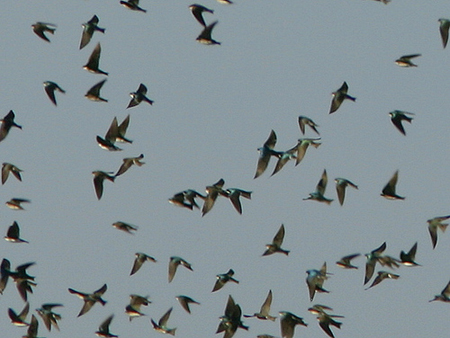
Concepts:
What do Tree Swallows do when nesting is over?
- For almost nine months of each year Tree Swallows are not nesting. But everything they do during this time is geared to staying alive so they can try to nest next season. That’s really what a songbird’s life is about.
- Therefore, the off season is a vital time. In the interval between nesting seasons many songbirds molt one or more times, replacing all or most of their feathers. And while a few bird species stay year-round where they nested, many others migrate away to spend winter where they have a better chance of survival.
Why do Tree Swallows flock together when not nesting?
- Most Tree Swallows move to large marshes soon after nesting. The attraction seems to be abundant food and beds of cattails or reeds for safe roosting at night.
- At these stopover or staging places juveniles can become adept at finding and capturing food, and both juveniles and adults can build their energy reserves.
- Now, instead of isolated territorial breeding pairs you are more apt to find a Tree Swallow in large flocks of from hundreds up to hundreds of thousands prior to migration!
- During these post-nesting summer months various swallow species often flock together to feed, preen, rest and roost.
- The stunning shot below taken by Mark Reinig of www.flickr.com/photos/onthemarkphotos/ shows a mixed group of four swallow species: Violet-green, Tree, Barn and Cliff.
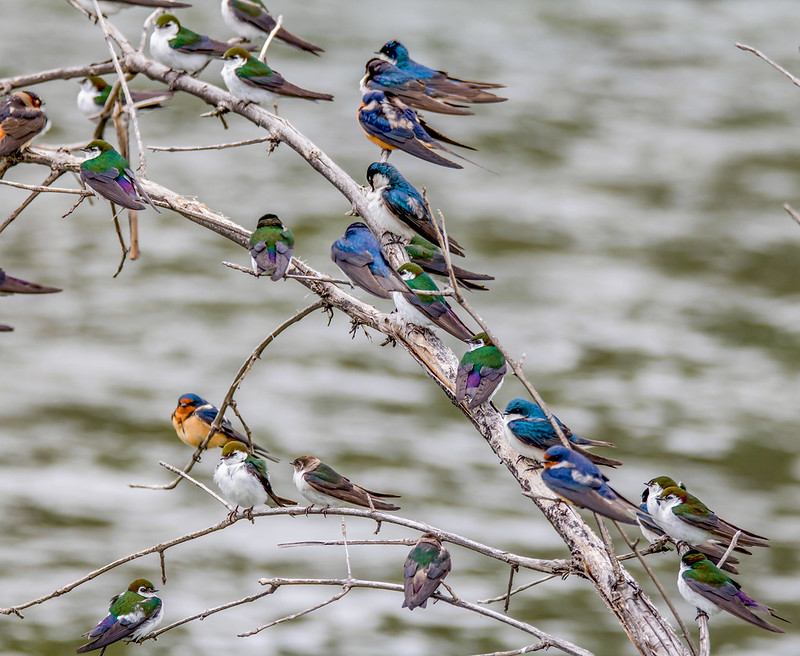
- Since many birds form flocks there must be advantages. But please note that the benefits of flocking can vary from species to species, and the reasons Tree Swallows flock may be different from those of some other songbirds.
One reason birds flock: more eyes and ears can detect predators easier.
- If a group has many members some will inevitably be looking and listening for danger at any given moment, so the rest should be able to spend more time searching for food and eating.
- Flocking may also make it harder for predators to single out prey from among the confusion of many moving birds.
- However, flocking can have disadvantages. Conspicuous flocks may attract predators like the Merlin below, which has just captured a Tree Swallow and appears to be severing its spine, falcon-style. Photo by Catherine Hamilton of Birdspot.
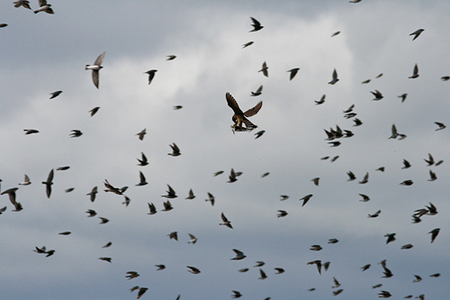
Another benefit of flocking: more eyes can discover food more efficiently.
- Bird species have been found to form feeding flocks if their food supply is usually restricted to scattered patches, especially if the patchy food is only temporarily abundant.
- Species of birds that forage on irregular insect swarms, moving schools of fish, or seasonal crops of seeds, fruits, and berries, typically feed in flocks.
- A Tree Swallow’s food is primarily flying insects, but unlike all other swallows Tree Swallows also eat certain small berries and seeds.
- Bird guides usually suggest Tree Swallows resort to berries in bad weather, but in truth they consume their favorite plant foods whenever they find them, regardless of the weather or season.
- For instance, we’ve often watched post-breeding flocks in western NY eating fruits of bayberry, shrub dogwood, red cedar, and arrowwood viburnum on hot, buggy August days. The swallows grasp the berries in their mouths, pluck them with a twisting motion of their heads, and gulp them down whole.
- The chart below shows how an average Tree Swallow’s percent of plant food varies over a year. You can see how important plants become in the non-nesting seasons.
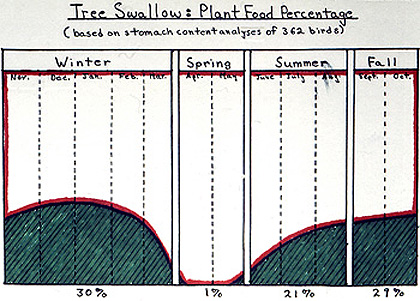
- So, since they prefer both flying insects and seasonally abundant plant foods it’s no wonder that after nesting Tree Swallows flock up to search for food.
What berries are Tree Swallows especially fond of?
- Tree Swallows can be considered specialized foragers. Their flocks seek out the persistent fruits of waxmyrtle and bayberry bushes that typically grow in sandy soils near seacoasts. They are one of the few bird species able to digest the energy-rich waxy outer coatings of these berries.
- Waxmyrtle and bayberry fruits grow in small, tight clusters (see below) that Tree Swallows can grab, twist off, and gulp down easily and quickly. We don’t think this convenient feature is coincidence.
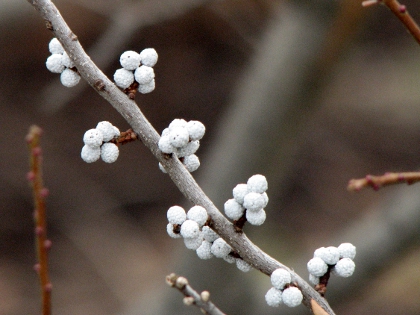
- Jessie Dickson’s photo below shows just a few of a flock of thousands of Tree Swallows she discovered feasting together on waxmyrtle berries.
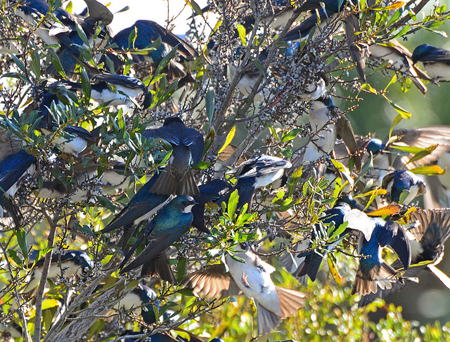
- Tree Swallows will stuff themselves with these berries when they’re available.
- The photo below shows 28 bayberries dissected from one road-killed swallow’s digestive tract. The waxy outer layer has already been digested from some. Had the bird lived, the hard seeds themselves would have been excreted.

- We suspect the Tree Swallow – Waxmyrtle/Bayberry relationship is highly important for both, with the swallows partially dependent on the berries for food in the non-nesting seasons and the plants partially dependent on the swallows for dispersal of their seeds.
- Here’s an extremely neat YouTube video of a flock of Tree Swallows feeding on a waxmyrtle bush.
A third possible reason some birds flock: flocks may contain older birds that know from experience where to find important resources.
- Inexperienced members of bird flocks can follow experienced ones to potential food supplies and shelter. So in a way flocks could be considered information centers.
- We suspect older birds in Tree Swallow flock already know from years past where important migration stopover areas are and where patches of bayberry, waxmyrtle, and other foods are located.
- Perhaps juveniles can learn by following these older individuals to resources. In this way information vital for survival could pass down from generation to generation.
- We also believe that young swallows could be following older experienced birds south on their migration paths to the wintering grounds, and migration is the subject we’ll tackle next. Photo below by Tony Leukering.
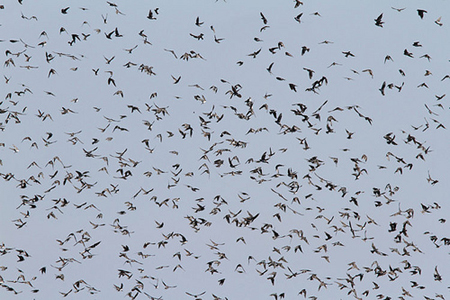
Why do so many songbird species migrate away from their nesting grounds?
- Migration is the regular, predictable movement of animals from one location to another location.
- Decrease in availability of food as seasons change is the main force driving post-nesting songbird migration in North America.
- Migration can demand lots of energy and may be dangerous, but for many birds the benefits outweigh the costs, because if they stayed on the breeding grounds they would almost certainly die during the off seasons.
- The nesting season usually coincides with maximum availability of food for nestlings. But when breeding is over and summer passes into fall, and winter nears, things change dramatically. There are fewer daylight hours for foraging, while at the same time colder temperatures require much more energy for survival.
- Many birds that depend on active insect food would starve if they tried to winter where they nest, since most northern insect species overwinter as eggs, larvae, or dormant adults, unavailable for many songbirds. Plus, seasonal crops of plant food are often exhausted long before winter ends.
- So, many songbirds have no good option but to migrate south to winter in warmer areas where food is more plentiful, but they don’t wait for winter to arrive. They migrate well before winter, while food to fuel their move can still be found along their migration routes.
- These songbird migrants aren’t driven by immediate hunger. They are programmed to migrate in order to avoid future predictable food shortages.
- Like breeding, migration is not a conscious choice. Instead, this behavior is stimulated by hormonal changes regulated by each bird’s “biological clock.”
How long does it take Tree Swallow flocks to move south and why are migration stopovers so important ?
- Compared to many other songbirds, Tree Swallows migrate south at a very leisurely pace.
- It usually takes Tree Swallows 3-4 months to travel from nesting grounds to wintering grounds. However, during this long period they may spend less than two weeks actually flying south!
- Research using tiny geolocators shows that after nesting, a Tree Swallow usually moves to one of 10 major North American stopover or staging regions. It then stays there for several weeks or even months, roosting, resting, molting, and building up its energy reserves.
- Tree Swallow stopovers typically center on large marshes where food can be found in surrounding areas and where flocks of swallows can roost at night in the relative safety of tall cattails or reeds growing up out of the water.
- After their long first stopovers each swallow begins moving south again. However, they may halt for one or more additional brief or even extended stopovers before finally reaching the area or areas where they will winter.
- Surprisingly, geolocators have also shown that Tree Swallows which nested in one area may use different stopover sites and take different migration routes south.
What is Tree Swallow life like in flocks on southbound migration?
- As mentioned, much of a Tree Swallow’s life during the 3-4 month journey south is spent in large flocks at stopover areas where they rest, refuel, and roost.
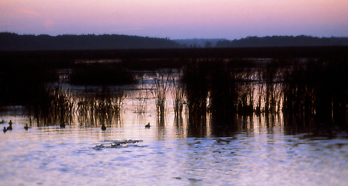
- Each morning shortly before sunrise the swallows rise up from the roosting marshes and spread out searching for food.
- These dispersing flocks are often large enough to create “roost rings” on weather radar scans. The radar registers each bird’s body as if it was a large drop of water.
- The sequence of photos below shows a huge ring made by a mixed species flock of swallows dispersing from a major overnight roost at Long Point, Ontario, on an August morning, as seen by US National Weather Service radar in Buffalo, NY.
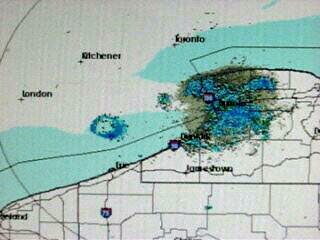
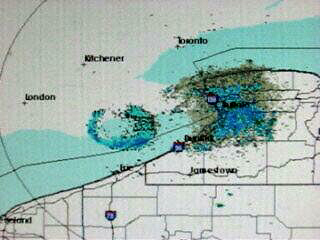
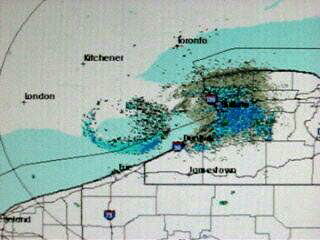
- Here’s a procedure for watching swallow roost rings on radar from late summer through mid-winter. Try it, it’s fun!
- When not foraging the flocks rest, sunbathe, and preen together on wires, beaches, and trees. Photo below by John Gavin.
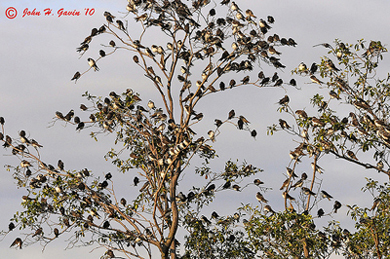
- Unfortunately, Tree Swallows are also attracted to warm road surfaces, and not all cars stop. Photo by John Gavin.
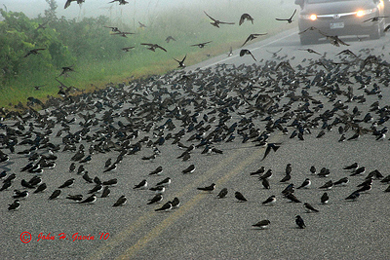
How do Tree Swallows behave when the huge flocks go to nightly roosts on migration?
- In the evening after sunset the swallows return again to marshes to roost. They may use either the one they left that morning or the next one along the migration chain.
- Going to roost is a dangerous time because such large concentrations of potential prey attract predators. As if not wanting to be the first to come in, thousands of Tree Swallows swirl overhead as dusk falls.
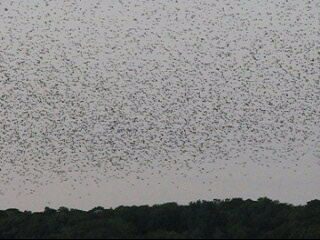
- Then, wave after wave of swallows dashes down into the marsh vegetation with a roar of wings. Photo below by Jo-Anna Ghadban
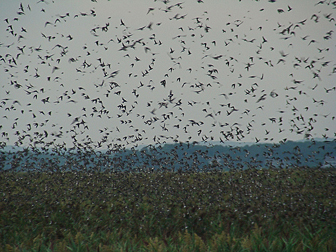
- Click this link to watch Brett Slattery’s YouTube video of Tree Swallows funneling as they come to roost. It’s truly awesome!
- And here’s another beautifully filmed YouTube video, this one by Mark Vance, of Tree Swallows going to roost. It includes two minutes of unusual low light action toward the end.
- Tree Swallows going to roost is an amazing sight, and it’s one you can see in person. If you’re in New England in late summer or early fall consider taking one of River Quest’s Connecticut River “Tree Swallow Sunset Cruises.” You’ll witness hundreds of thousands of Tree Swallows converging at sunset and diving into their island roost.
- Roger Tory Peterson, a man who knew a bit about birds, and who lived not far from this Connecticut stopover marsh, once said “- – for sheer drama, the tornadoes of Tree Swallows eclipsed any other avian spectacle I have ever seen.”
What routes do Tree Swallow flocks take on their migration south?
- Each bird species that migrates uses one or more general routes of travel.
- Tree Swallows migrating south typically follow one of three major flyways.
- Tree Swallows that breed from eastern Canada, the Great Lakes and northeastern United States usually gravitate to the Atlantic seacoast.
- You can track their progress using the procedure mentioned earlier for watching National Weather Service radar. For instance, notice the four huge early morning roost rings swallow flocks created in the photo below.
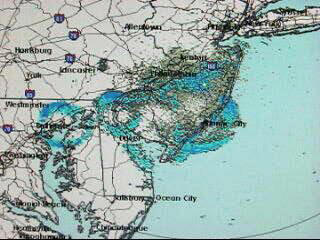
- Once there, they follow the coast gradually south to Florida. Some continue on as far as Cuba.
- Populations from Alaska, central Canada and the U.S. midwest follow Mississippi River basin waterways south to Louisiana. They may remain there through winter or continue on to eastern Mexico, Central America, or Florida.
- Tree Swallows from western North America migrate west of the Rocky Mountains to winter in western Mexico and Central America.
- EBird now offers an excellent Tree Swallow “Abundance Animation” video showing the species’ annual movement patterns.
- Most Tree Swallow migration is overland. However, they are able to cross large bodies of water if necessary. For instance, some fly from Florida to Cuba, or from Louisiana to the Yucatan Peninsula of Mexico.
- Data collected by light-weight geolocators like the ones below is helping ornithologists determine songbird migration routes with greater precision. Photos courtesy of the Alaska Songbird Institute.

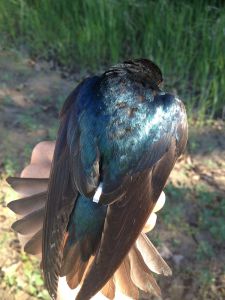
How do the Tree Swallow flocks know where to go on migration? How do they find their way?
- The fascinating navigational techniques used by night migrants are beyond the scope of this web site. However, be aware night migrants must possess both a “map” to pinpoint where they are at any moment and a “compass” to set their flight directions.
- By contrast Tree Swallows are among the minority of songbirds that migrate primarily during the daylight hours.
- Although day migrants are more exposed to avian predators there are some advantages. Day migrants are able to navigate using land formations they can see easily, such river valleys, coastlines, and mountain ranges.
- And, unlike night migrants, those that migrate by day can feed as they go. For Tree Swallows this means they can hunt both flying insects and their favorite berries.
Questions for next topic: Tree Swallow Molt and Wintering
- When do Tree Swallows molt their feathers?
- Where do most Tree Swallows spend the winter?
——————————————————————————–
Home: Tree Swallow Nest Box Projects
Creating Tree Swallow Nest Box Projects
Spring Return
Nesting Season Behavior
Song and Calls
Nest Site Claiming
Pair Formation
Nest Building
Bird Flight
Mating and Paternity
Diary of One Season at Salmon Creek
Monitoring Nest Boxes and Keeping Records
Making Box Checks Keeping Box Records Control Sheets Season Summaries Print Sheets
Banding Your Tree Swallows Banding Adults Banding Nestlings
Tree Swallows in Research Research Bibliography Glossary of Terms